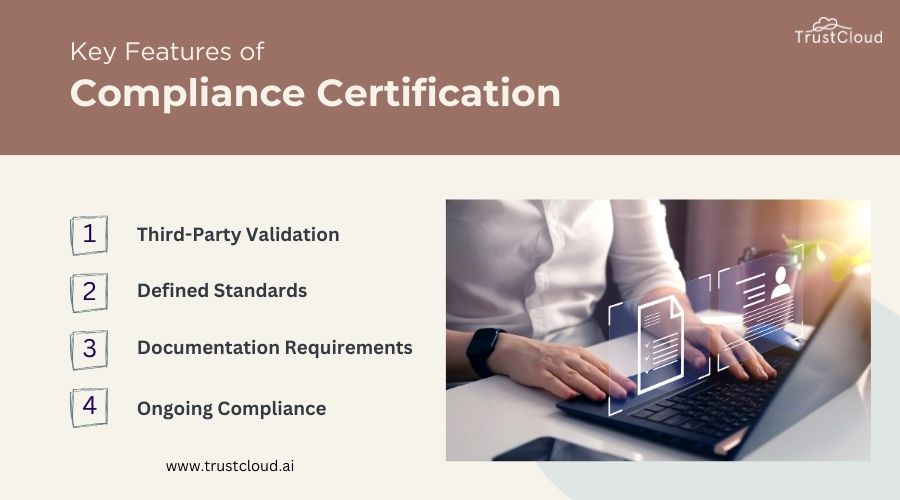Compliance Certification vs Attestation: What is the difference?
The Compliance Certification vs Attestation article talks about the difference between the two.
In today’s highly regulated business environment, compliance with industry standards and regulatory requirements is not just a priority but a necessity. Two commonly used terms in this realm are “compliance certification” and “attestation.” While they may seem similar, they carry distinct meanings and implications for organizations seeking to demonstrate adherence to relevant regulations and standards.
Compliance certification and attestation are both vital processes in various industries that ensure entities adhere to established regulatory standards and guidelines. While they share the common goal of verifying adherence to certain norms, their methods, implications, and authority differ significantly.
Compliance certification is a formal process that is typically carried out by an accredited third-party organization or body. This process involves a thorough evaluation and audit of a company’s operational procedures, systems, and controls to ensure they meet specific standards or regulations. Upon successful evaluation, the entity is awarded a certification, which serves as concrete evidence that it complies with the relevant industry or governmental standards. This certification often has a validity period after which the entity must undergo re-evaluation to maintain its certified status.
Attestation, on the other hand, is generally an assertion or acknowledgment made by an entity’s management or an authorized representative that declares compliance with certain criteria or standards. Unlike certification, attestation does not always require the involvement of an external auditor and may not involve a detailed assessment process. Attestation can be seen as a self-asserted confirmation that is sometimes subsequently verified by an external party.
In summary, compliance certification is typically a more formal and rigorous process that results in a recognized credential indicating adherence to standards, while attestation is a declaration of compliance that may or may not be independently verified.
Let’s delve into the differences between compliance certification and attestation, exploring their roles, processes, and benefits.
Understanding compliance certification
Compliance certification refers to the process through which an organization obtains formal recognition or accreditation from a certifying body, confirming its adherence to specific standards, regulations, or industry best practices. These certifications are often awarded based on a comprehensive assessment of the organization’s policies, procedures, and controls, conducted by accredited auditors or certification bodies.
Compliance certification is akin to earning a seal of approval from a recognized body that your organization adheres to certain standards. This process is not just about checking boxes but also ensuring that your operations align with prescribed regulations and standards. It’s a proactive approach to governance, risk management, and compliance (GRC) that not only mitigates risks but also enhances operational efficiency.
The journey towards compliance certification involves a thorough assessment of an organization’s policies, procedures, and controls against industry standards. This is usually followed by a gap analysis to identify areas of improvement and the implementation of necessary changes to meet the certification criteria. Once these steps are successfully completed, the organization undergoes a rigorous audit conducted by a certifying body. If the audit is passed, the organization is awarded certification.
The benefits of compliance certification are manifold. It not only enables organizations to demonstrate their commitment to industry standards and regulations but also boosts customer confidence and trust. In a world where data breaches and compliance failures often make headlines, being certified can serve as a significant competitive advantage.
Types of compliance certifications
There are various types of compliance certifications available, each tailored to different industries and standards. For instance, the ISO 27001 certification is sought after by organizations looking to secure information management systems. Similarly, the Health Insurance Portability and Accountability Act (HIPAA) certification is crucial for entities handling protected health information in the United States.
Another notable certification is the Payment Card Industry Data Security Standard (PCI DSS) for organizations that handle credit card transactions. This certification ensures that companies have measures in place to protect cardholder data. Meanwhile, Sarbanes-Oxley Act (SOX) compliance impacts publicly traded companies, mandating them to follow strict financial reporting and auditing procedures.
Choosing the right compliance certification depends on your industry, the nature of your operations, and the specific regulations you need to adhere to. It’s essential to conduct thorough research and possibly consult with a compliance professional to determine which certification best aligns with your organization’s needs.
Key features
Compliance certification has become a cornerstone for organizations striving to demonstrate their commitment to meeting industry standards and regulatory requirements. This pivotal process involves undergoing rigorous assessments by accredited bodies to validate adherence to specific standards, frameworks, or legal mandates. At its core, compliance certification serves as a hallmark of excellence, providing stakeholders with the assurance that an organization has implemented robust policies, procedures, and controls to mitigate risks and safeguard against non-compliance.

Following are the key features of compliance certification:
- Third-Party Validation: Compliance certifications typically involve third-party assessment and validation, providing impartial confirmation of an organization’s compliance status.
- Defined Standards: Certification processes are aligned with predefined standards or frameworks, such as ISO (International Organization for Standardization) standards, industry-specific regulations, or cybersecurity frameworks like SOC 2 (Service Organization Control 2).
- Documentation Requirements: Organizations seeking certification must demonstrate adherence to specific requirements outlined in the relevant standards or regulations, often through comprehensive documentation and evidence of implementation.
- Ongoing Compliance: Certification is not a one-time achievement but an ongoing commitment to maintaining compliance with the applicable standards or regulations. Organizations must undergo periodic audits or assessments to retain their certification status.
Examples
- ISO 27001: Certifies that an organization has implemented an Information Security Management System (ISMS) in accordance with the ISO/IEC 27001 standard, demonstrating a commitment to managing information security risks effectively.
- PCI DSS: Ensures compliance with the Payment Card Industry Data Security Standard (PCI DSS), validating an organization’s ability to securely process, store, and transmit payment card data.
- HIPAA: Verifies compliance with the Health Insurance Portability and Accountability Act (HIPAA), safeguards protected health information (PHI) and ensures privacy and security in the healthcare industry.
Understanding attestation
Attestation, on the other hand, involves a formal statement or assertion made by an individual or entity, often a qualified professional, affirming the accuracy or compliance of certain assertions, statements, or controls. Unlike certification, which involves a comprehensive assessment by a third party, attestation relies on the expertise and credibility of the attesting party to provide assurance regarding specific matters.
Key features of attestation
- Professional assertion: Attestation involves a professional, such as a certified public accountant (CPA) or auditor, providing an independent opinion or assertion regarding the accuracy or compliance of certain statements or controls.
- Limited scope: Attestation may focus on specific assertions or controls rather than comprehensive compliance with a particular standard or framework. It is often tailored to address specific concerns or requirements of stakeholders.
- Credibility and trust: The credibility and reputation of the attesting party play a significant role in the reliability and trustworthiness of the attestation statement. Stakeholders rely on the expertise and independence of the examiner when assessing the validity of the assertion.
- Customized reporting: Attestation reports may vary in format and content based on the specific requirements of stakeholders or regulatory bodies. They can range from formal opinion letters to detailed reports providing insights into the effectiveness of controls or processes.
Examples of attestation
- SOC reports: Service Organization Control (SOC) reports, such as SOC 1, SOC 2, and SOC 3, are commonly used for attestation purposes. These reports are issued by auditors or CPA firms and provide assurance regarding the effectiveness of controls relevant to financial reporting, security, availability, processing integrity, confidentiality, or privacy.
- Attestation engagements: Attestation engagements can cover a wide range of assertions or controls, including financial statements, compliance with regulatory requirements, cybersecurity controls, or data privacy practices. These engagements involve the issuance of an attestation report by a qualified professional, providing assurance regarding the accuracy or compliance of the subject matter.
Navigating certification and attestation:
While both compliance certification and attestation serve essential roles in demonstrating adherence to standards and regulations, organizations must understand their differences and choose the most appropriate approach based on their needs, industry requirements, and stakeholder expectations.
Choosing Between Certification and Attestation
- Scope and objectives: Consider the scope and objectives of your compliance efforts. Certification is suitable for demonstrating comprehensive compliance with predefined standards or frameworks, while attestation may be more appropriate for addressing specific assertions or controls.
- Stakeholder requirements: Assess the expectations and requirements of your stakeholders, including customers, regulators, business partners, and investors. Choose the approach that provides the necessary level of assurance and transparency to meet their needs.
- Resource considerations: Evaluate the resources, expertise, and time required to pursue certification or attestation. Certification may involve a more extensive and rigorous process, while attestation engagements can be tailored to address specific concerns or requirements efficiently.
- Industry best practices: Seek guidance from industry best practices, regulatory guidelines, or standard frameworks relevant to your organization’s operations. Consider consulting with compliance professionals or advisors to determine the most suitable approach for your compliance objectives.
Conclusion
In summary, compliance certification and attestation are two distinct approaches for demonstrating adherence to standards and regulations, each offering unique benefits and considerations. Certification involves a comprehensive assessment by a third party, providing formal recognition of compliance with predefined standards or frameworks. Attestation, on the other hand, relies on the professional assertion of an independent party, providing assurance regarding specific assertions or controls.
By understanding the differences between certification and attestation and choosing the most appropriate approach based on their needs and objectives, organizations can navigate the complexities of compliance effectively and build trust with stakeholders.
Sign up with TrustCloud to learn more about how you can upgrade GRC into a profit center by automating your organization’s governance, risk management, and compliance processes.
Explore our GRC launchpad to gain expertise on numerous GRC topics and compliance standards.



